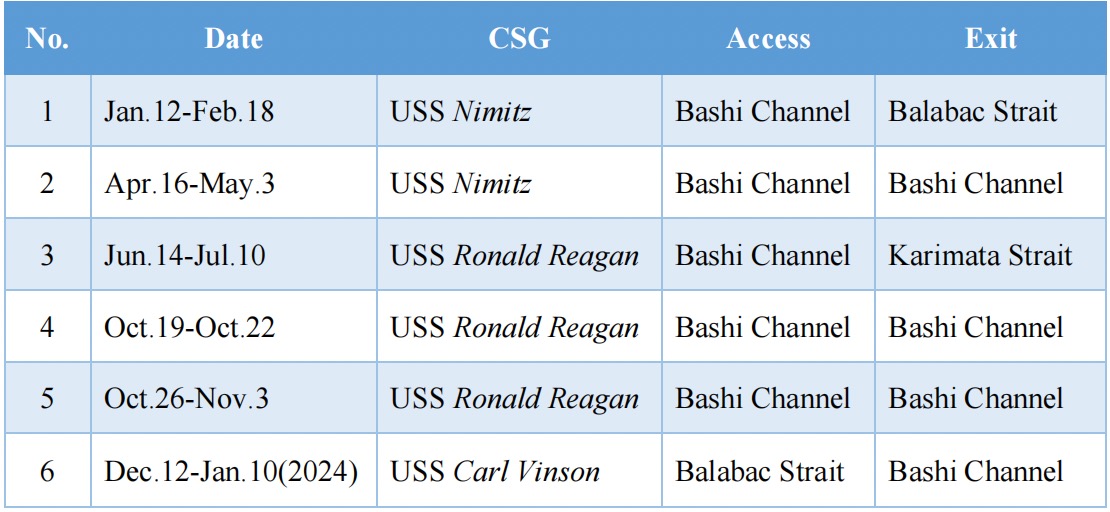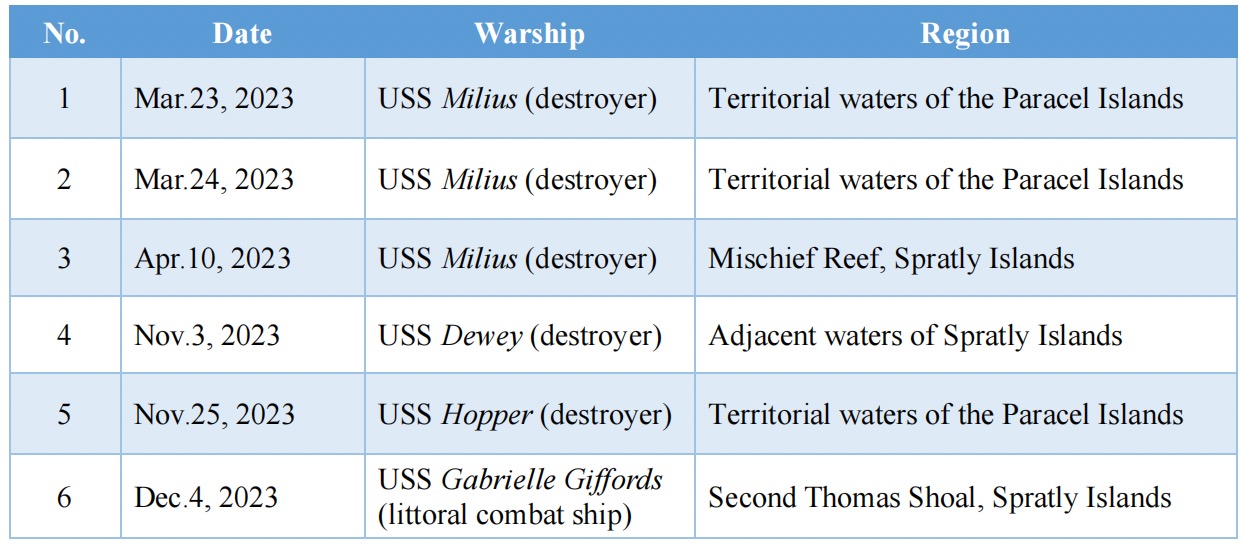Perface
In peacetime, conducting highly-intensified military activities in a coastal state’s surrounding waters, such as thousands of close-in reconnaissance operations and hundreds of military exercises, is contrary to the spirit of “maintaining international peace and security” of the UN Charter and “the peaceful uses of the seas” of the United Nations Convention on the Law of the Sea (UNCLOS).
Since 2009, US military activities against China in the South China Sea have strengthened in frequency and intensity. Even against the back drop of the Russia-Ukraine conflict and the Israeli–Palestinian conflict, US is still vigorously hyping up the “China threat” and accelerating the layout of Indo-Pacific Strategy. US military operations in the South China Sea continued unabated in 2023. Some operations are even unusually close to the coast of mainland China, and unmanned platforms have begun to be used on a large scale, significantly increasing the risk of maritime and air frictions and conflicts between China and the US.
In 2023, the politicization of military operations by the US military has been further enhanced, with increased exposure to the Taiwan Strait transit operations, deployments of carrier strike groups (CSGs), submarine activities, US-Philippine joint patrols, military exercises and drills. Meanwhile, the Pentagon and the US military have also repeatedly highlighted the so-called “dangerous interception” or “unprofessional” actions of the People's Liberation Army (PLA) at sea to put diplomatic, public and strategic pressure on China.
The US military presence and operations in the South China Sea are major factors affecting the situation in the South China Sea. Since 2019, the South China Sea Strategic Situation Probing Initiative (SCSPI) has been releasing this annual report, An Incomplete Report on US Military Activities in the South China Sea. The report is intended to promote the transparency of South China Sea Situations and provide the perspective of a third-party think tank for reference to government departments, research institutions, media and the public of related parties.
Director of SCSPI Hu Bo 
Key Findings
I. Continuously Strengthened Strategic Platforms’ Activities
1.CSGs
In 2023, the US deployed three CSGs, namely USS Nimitz (CVN-68), USS Ronald Reagan (CVN-76), and USS Carl Vinson (CVN-70), for a total of six activities accessing the South China Sea. Compared to previous years, the duration of activities increased, with a preference for entering and exiting through the Bashi Channel, and the scale of the exercise and drills was expanded and the number of exercise subjects was increased.
The US CSG deployments focused on the Vanguard Basin, west of the Bashi Channel and north of the Indonesia-Malaysia border waters, and the east and west major shipping lanes of the South China Sea. Targeted large-scale drills had been conducted in the region multiple times.
2.ARGs
In 2023, the US military successively dispatched two ARGs, USS Makin Island and USS America, for activities in the South China Sea.
Under the concept of the Lightning carrier, USS Makin Island equipped with F35B can not only operate in synergy with CSGs but also serve as an alternative to an aircraft carrier in some occasions, enhancing the overall operational capability of the US military.
Additionally, USS America, USS Makin Island and the 13th MEU conducted integrated operations in the Western Pacific, demonstrating the capability to implement operational concepts such as “Expeditionary Advanced Base Operations” (EABO).
3.Submarines
In 2023, the US Navy deployed at least 11 nuclear attack submarines plus two ballistic nuclear missile submarines for strategic cruise missions in the Western Pacific including the South China Sea. As a means of signalling and public relations, the US Navy has a growing motivation to disclose the operational status of its submarines and expose their locations.
4.Bombers
In 2023, the US Air Force conducted 30 B-52H or B-1B bomber sorties in the Western Pacific in total. Bombers operating in the region are primarily deployed at Andersen Air Force Base in Guam, but in 2023, they also operated from multiple allied and partner countries’ airports.
II. Aggressively Rising of Close-in Marine and Aerial Reconnaissance
1.Intensifying Aerial Close-in Reconnaissance
In 2023, the US military conducted around 1,000 sorties in various types of large reconnaissance aircraft from bases such as Kadena in Okinawa, Osan in South Korea, Andersen in Guam, and Clark in the Philippines for reconnaissance missions in the South China Sea throughout the year. Among them, about 100 sorties approached the airspace near the Chinese mainland and Hainan Island, most being within 30 nautical miles of the baseline of the territorial sea. The US reconnaissance aircraft also frequently disrupted the normal exercises and drills of the PLA by intruding into relevant maritime and airspace, leading to close encounters with Chinese alert forces.
2.Increasingly Targeted Maritime Reconnaissance Activities
In 2023, US reconnaissance ships such as ocean surveillance ships and oceanographic survey ships proceeded with more targeted routine operations in the South China Sea and kept intensified reconnaissance in the triangular area between the Paracel Islands, Spratly Islands, and the Bashi Channel, as well as the east and west lanes in the South China Sea, accumulating a total of 314 ship-days. Babuyan Channel, Verde Island Passage and Mindoro Strait, as frequently used maritime passages by US CSGs in recent years, have also seen intensive reconnaissance operations by US oceanographic survey ships.
III. Multiple Declaratory Operations
1.Island-intrusive FONOPs
In 2023, there has been an increased frequency of the US military’s island-intrusive FONOPs in the South China Sea, rising to six times. Of note is the rare intrusion of a US warship into the waters adjacent to Second Thomas Shoal in the Spratly Islands on December 4.
2.Taiwan Strait Transits
Throughout 2023, US warships transited the Taiwan Strait six times, suggesting a significant decrease compared to previous years, while there was a substantial increase in the frequency of the USN P-8A aircraft flyover.
Besides, the diversification of naval forces transiting the strait was observed. The US has conducted 3 joint transits together with Canada around the year. On June 21, the USCG Stratton transited the Taiwan Strait, which is the first solo transit of the Taiwan Strait by a US Coast Guard vessel after 2019.
IV. Remarkably Boosted Joint Operations with Allies
1.EDCA and US-Philippine Military Cooperation
In 2023, the US has emphasized its commitment to the US-Philippine military alliance repeatedly and advanced military cooperation with the Philippines through the Enhanced Defense Cooperation Agreement (EDCA). Based on promoting investment, construction and presence in the five existing bases, four new bases will also be established and operated in the Philippines and three of them are located near Taiwan.
Amidst increasing tensions in areas such as Second Thomas Shoal and Scarborough Shoal, the US issued official statements emphasizing its support for the Philippines. During various confrontations and frictions between China and the Philippines, the US military deployed P-8A aircraft or various types of unmanned reconnaissance aircraft to provide real-time intelligence support to the latter and monitored the operations of both sides.
2.Joint Operations with Japan, Australia and Other Allies
First, there was a growth in joint exercises and training intensity with Japan and Australia. Under the trilateral framework of the US, Japan and Australia, according to incomplete statistics, Japan and Australia have participated in dozens of US-led multilateral drills in the Western Pacific region in 2023.
Second, there was an emphasis on policy coordination and interoperability with Japan and Australia. The US, Japan and Australia held a trilateral defense ministers’ meeting and issued a joint statement, committing to future trilateral F-35 joint strike fighter training in Australia, increased trilateral exercises and accelerated information-sharing cooperation.
Third, there has been a significant increase in arms sales to Japan and Australia. According to the AUKUS declaration, the US plans to deploy nuclear-powered attack submarines in Australia on a rotational basis by the end of 2027. The US also agreed to advance the timeline for Japan’s introduction of the US-made Tomahawk cruise missiles to 2025.
3.Strengthen Regional Maritime Domain Awareness
First, strengthening the development of unmanned combat platforms and space-based reconnaissance networks was observable. In 2023, to enhance its maritime domain awareness capabilities, the USMC Marine Air-Ground Task Force was newly equipped with MQ-9A Reaper unmanned aircraft in 2023. Meanwhile, the USN MQ-4C Triton unmanned aircraft had been deployed, and conducted operations in the South China Sea and the Taiwan Strait.
The US Space Force had accelerated the construction of its space-based satellite detection system. SpaceX launched the first batch of 10 missile tracking and communication satellites of the Proliferated Warfighter Space Architecture. SpaceX also sent the US military’s X-37B Orbital Test Vehicle into space.
Second, strengthening cooperation with allies to build a situational awareness network. In recent years, the US has been actively promoting the construction of multi-lateral mechanisms involving regional allies and partners and the establishment of a maritime situational awareness system. By providing military assistance, maritime support, and personnel training to regional countries, the US continued to strengthen the maritime capabilities and expand the maritime domain awareness of other South China Sea claimants, regional allies and partners. These efforts aimed to deter potential adversaries and maintain regional power advantage.
V. Exercises and Drills for Enhancing Combat Readiness
1.Deepening Participation of Allied and Partner Countries
In 2023, the US military conducted a total of 107 large-scale exercises and drills in the South China Sea and its surrounding areas, an increase in both quantity and scale compared to 2022.
2.Shifting of Multiple Exercise Locations to the Western Pacific
A number of large-scale exercises have shifted or expanded from traditional exercise areas to strategically crucial areas in the Western Pacific.
3.Constantly Innovating Exercise Subjects
In 2023, with the introduction of unmanned combat concepts represented by the US Department of Defense’s Replicator Initiative, the emphasis of exercises shifted towards enhancing maritime domain awareness and the use of unmanned combat platforms.




Content
I. Continuously Strengthened Strategic Platforms’ Activities
II. Aggressively Rising of Close-in Marine and Aerial Reconnaissance
III. Multiple Declaratory Operations
IV. Remarkably Boosted Joint Operations with Allies
V. Exercises and Drills for Enhancing Combat Readiness
VI. Summary and Outlook
Appendix
请下载PDF文件阅读完整报告

